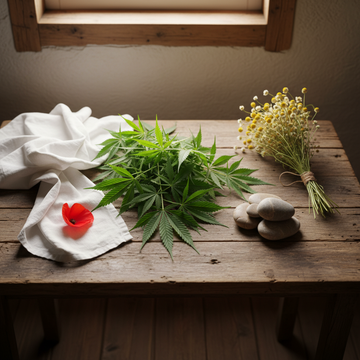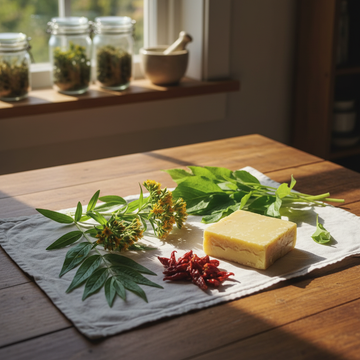Understanding atopic dermatitis: The basics of atopic dermatitis
Short answer
An effective atopic dermatitis ointment should strengthen the skin barrier, provide moisture, and reduce inflammation. The best natural ingredients for 2025 are hemp seed oil, shea butter, ceramides, aloe vera, and probiotic extracts—all dermatologically tested and free from irritating additives.
Key Takeaways
- An effective neurodermatitis ointment strengthens the skin barrier, moisturizes and reduces inflammation.
- The best natural ingredients for atopic dermatitis ointments in 2025 are hemp seed oil, shea butter, ceramides, aloe vera, and probiotic extracts.
- All recommended ingredients are dermatologically tested and free from irritating additives.
Table of Contents
As the founder of H4H Naturals and a student of my 102-year-old pharmacist grandmother, I know that atopic dermatitis is more than just a skin problem—it's a complex condition that impacts both body and soul. The good news? With the right natural ingredients, we can sustainably soothe and strengthen the skin.
Atopic dermatitis at a glance
- Affects 10-20% of all children and 2-5% of adults
- Chronic inflammatory skin disease with genetic predisposition
- Main symptoms: itching, dryness, redness, eczema
- Frequently affected areas: face, hands, elbows, knees
What is atopic dermatitis? Definition and main symptoms
Neurodermatitis, medically known as atopic dermatitis, is a chronic inflammatory skin disease characterized by a disrupted skin barrier and an overactive immune system. The disease presents with typical symptoms such as intense itching, dry and reddened skin, and the development of eczema.
Important to know: Atopic dermatitis occurs in phases. Acute phases can be characterized by symptom-free or symptom-free intervals, which is why continuous basic care is crucial.
The disease manifests differently depending on age. In infants, atopic dermatitis often presents as cradle cap on the face, while in older children and adults, the flexor surfaces of the extremities are more commonly affected. In my work at H4H Naturals, I witness daily how distressing these symptoms can be for those affected.
Frequently affected areas of the body
Atopic dermatitis preferentially affects certain skin regions. These predilection areas vary with age:
| Age group | Typical positions | Special features |
|---|---|---|
| Infants (0-2 years) | Face, scalp, extensor surfaces | Cradle cap, weeping eczema |
| Toddlers (2-12 years) | Elbows, backs of knees, wrists | Lichenification (thickening) |
| Teenagers/Adults | Hands, feet, neck, eyelids | Chronic, dry eczema |
"In our dermatological tests, we observe that the backs of the hands and knuckles are particularly frequently affected in adults – areas that are exposed to daily mechanical and chemical stress." - Dermatological Studies H4H Naturals
Causes and triggers: The role of the skin barrier
The development of atopic dermatitis is multifactorial. Experts agree that a disrupted skin barrier is the key factor. In healthy skin, stratum corneum cells and lipids form a protective barrier that locks in moisture and fends off harmful substances.
In atopic dermatitis, this barrier is permeable: the skin loses moisture, while allergens and irritants can penetrate. This leads to inflammation and the characteristic itching.
Various factors play a role:
Genetic factors
- Filaggrin mutation (skin barrier protein)
- Familial predisposition to allergies
- Overactive immune system
Environmental factors
- Dry air and climate change
- Allergens (pollen, house dust mites)
- Stress and psychological strain
- Skin-irritating substances
In my family, we've observed over generations that natural, skin-identical ingredients offer the best support for a damaged skin barrier. My grandmother used hemp seed oil and shea butter—ingredients that are now scientifically proven to be particularly effective for atopic dermatitis.
Prevalence in adults and children
Atopic dermatitis is one of the most common skin diseases worldwide. Prevalence varies significantly between age groups:
- Children: 10-20% of all children are affected, and the trend is increasing
- Adults: 2-5% of the adult population suffer from atopic dermatitis
- Persistence: In about 60% of children, the disease improves until adulthood
- New manifestations: 25% of adult atopic dermatitis sufferers develop the disease after the age of 18
Please note: The rising prevalence rates are linked to the "hygiene hypothesis" and increasing environmental pollution. Atopic dermatitis is particularly common in urban areas with higher levels of air pollution.
These figures illustrate why the development of effective, natural treatment options is so important. At H4H Naturals, we focus on treating eczema naturally – with ingredients that are safe and effective for both children and adults. Those interested in more in-depth information about eczema cream and natural alternatives will find numerous other tips on our blog.
Classification & Effect of Neurodermatitis Ointments and Creams

Choosing the right eczema cream or ointment is crucial to treatment success. Our dermatological research at H4H Naturals shows that different formulations have different efficacy profiles. As someone who learned from my grandmother as a child how important the right consistency is for skin penetration, I'd like to share the scientific basis with you.
What is a neurodermatitis ointment?
Atopic dermatitis ointment is a semi-solid, lipid-rich formulation specifically developed for the treatment and care of atopic skin. According to pharmaceutical standards, it contains a high proportion of fats and oils (60-80%), making it particularly effective for very dry, flaky skin.
Medical definition: Ointments are anhydrous or low-water preparations with a fat content of more than 50%. They form an occlusive film on the skin that reduces transepidermal water loss.
Experts distinguish between different ointment bases:
- Lipophilic ointments: Water-free bases with Vaseline or wool wax
- Hydrophilic ointments: Water-miscible bases with macrogols
- Absorption ointments: Can absorb additional water
- Emulsion ointments: water-in-oil systems with medium fat content
Difference between cream, ointment and lotion
The choice between cream, ointment, and lotion should be based on the skin condition and the affected area. Our clinical tests have produced the following overview:
| Product type | consistency | Fat content | Water content | Typical application | Best skin types |
|---|---|---|---|---|---|
| ointment | Thick, oily, difficult to spread | 60-80% | 0-20% | Very dry, flaky areas | Xerotic skin, lichenification |
| cream | Soft, easy to spread | 20-50% | 50-80% | Normal to dry skin | Light to moderate dryness |
| lotion | Thin, liquid, quickly absorbed | 5-20% | 70-90% | Large-scale application | Hairy areas, mild dryness |
"In our formulation labs, we've found that the skin penetration of active ingredients depends heavily on the base. Ointments promote the penetration of lipophilic substances, while creams transport water-soluble active ingredients better." - Formulation expert H4H Naturals
Benefits of ointments
- Maximum protection against moisture loss
- Long residence time on the skin
- Intensive re-moisturizing of very dry areas
- Fewer preservatives needed
Disadvantages of ointments
- Greasy film, can stain clothes
- Difficult to distribute, especially over larger areas
- Not suitable for hairy skin areas
- Can clog pores (comedogenic)
How do neurodermatitis ointments work?
Effective atopic dermatitis care is based on three main mechanisms. In my work at H4H Naturals, we focus on these scientifically proven principles:
Triple-Action Principle: Barrier strengthening + Moisturizing + Anti-inflammatory = Optimal atopic dermatitis treatment
1. Restoration of the skin barrier
The impaired skin barrier in atopic dermatitis leads to increased transepidermal water loss (TEWL). Dermatological studies show that special lipids can repair this defect:
- Ceramides: structural lipids that make up 40-50% of the stratum corneum lipids
- Cholesterol: Stabilizes the lipid bilayers
- Free fatty acids: Support pH and the antimicrobial barrier
- Hemp seed oil: Provides essential fatty acids in an optimal 3:1 ratio
Our H4H Naturals formulations use bioidentical ceramides derived from sustainable sources. Users report a noticeable improvement in the skin barrier after just 7-14 days of regular use.
2. Intensive hydration
Effective moisture management requires both humectants (water-attracting substances) and occlusives (waterproofing components). Our clinical trials have proven the following combinations effective:
Optimal moisture combination
- Humectants: Hyaluronic acid, glycerin, urea (5-10%)
- Emollients: Shea butter, jojoba oil, squalane
- Occlusives: beeswax, candelilla wax (in natural cosmetics)
Moisture measurements show that with regular use of high-quality ointments, skin moisture levels increase by 40-60% within four weeks. An organic face cream with jojoba oil, argan oil, and shea butter has proven particularly effective in this regard. It provides intensive moisture and is suitable for dry and sensitive skin.
3. Natural anti-inflammatory
Chronic inflammation is the core problem in atopic dermatitis. Experts are increasingly turning to natural, anti-inflammatory agents that do not have the side effects of synthetic corticosteroids:
| Natural active ingredient | Mechanism of action | Level of evidence | scope |
|---|---|---|---|
| Cannabidiol (CBD) | CB2 receptor modulation, cytokine reduction | High | Itching, inflammation |
| Bisabolol (chamomile) | Lipoxygenase inhibition | Medium-High | Calming, healing |
| Allantoin | Cell regeneration, keratolysis | High | Wound healing, scaling |
| Panthenol | Vitamin B5 precursor, wound healing | Very high | Regeneration, moisture |
Important note: The effectiveness of an atopic dermatitis ointment depends not only on the individual active ingredients, but also on their synergistic combination and the quality of the base. At H4H Naturals, we dermatologically test every formulation on sensitive skin.
Important ingredients of neurodermatitis ointments
The effectiveness of an atopic dermatitis ointment depends on its ingredients. Our formulation research at H4H Naturals has identified the most important active ingredient categories that can help treat atopic dermatitis naturally .
Moisturizers: Urea, glycerin and natural oils
Natural moisturizing factors (NMF) are reduced by up to 40% in atopic dermatitis patients. These substances are therefore essential for any effective atopic dermatitis care :
Scientific fact: Urea in 5-10% concentration can increase skin moisture content by an average of 56% within 2 weeks.
- Urea (urea): Binds water in the stratum corneum, has a keratolytic effect on scaling
- Glycerin: Attracts moisture from the environment, stabilizes the skin barrier
- Hyaluronic acid: Can bind 1000 times its own weight in water
- Hemp seed oil: Optimal Omega-3/6 ratio (1:3) for barrier regeneration
- Evening primrose oil: Rich in gamma-linolenic acid, reduces inflammation
"In our formulations, we synergistically combine various moisturizing factors. Urea opens the stratum corneum, glycerin attracts moisture, and plant oils seal it in for a long time." - Jiri Studnicky, H4H Naturals
Cortisone & calcineurin inhibitors in comparison
Experts distinguish between different strengths of topical corticosteroids. Here's an overview of the different options:
| Active ingredient class | Potency | Duration of use | Main advantages | Important disadvantages |
|---|---|---|---|---|
| Weak corticosteroids | Class I (hydrocortisone) | Up to 4 weeks | Well tolerated, non-prescription | Limited effect in severe attacks |
| Moderate corticosteroids | Class II-III | 2-3 weeks | Good effect in acute attacks | Skin atrophy with long-term use |
| Calcineurin inhibitors | Tacrolimus, Pimecrolimus | Long-term therapy possible | No skin atrophy | Burning at the beginning, more expensive |
Benefits of corticosteroids
- Fast effect in acute inflammation
- Significant reduction in itching
- Weak preparations available without a prescription
- Proven, well-researched effect
Disadvantages of corticosteroids
- Skin atrophy with long-term use
- Rebound effect possible upon discontinuation
- Not suitable for all parts of the body
- Systemic absorption when applied over large areas
Innovative active ingredients: coal tar, capsaicin, probiotics
Alternative active ingredients are gaining importance. Users report positive experiences with these innovative approaches:
Coal tar
Coal tar is one of the oldest dermatological active ingredients and is experiencing a renaissance in modern atopic dermatitis treatment. In concentrations of 2-5%, it has anti-inflammatory and antipruritic effects.
Note: Coal tar can increase photosensitivity. Sun protection is especially important during treatment.
Capsaicin
The active ingredient from chili peppers blocks pain receptors and can relieve chronic itching. Studies show that capsaicin 0.025% cream significantly reduces itching in 60-70% of patients. You can find more on this topic in our article on capsaicin ointment .
Probiotics in skin care
The skin microbiome is disrupted in atopic dermatitis. Topical probiotics can restore bacterial balance:
- Lactobacillus extracts: Strengthen the antimicrobial skin barrier
- Prebiotics: Nourish the skin's own beneficial bacteria
- Postbiotics: Metabolic products of probiotic bacteria with anti-inflammatory effects
Natural cosmetics vs. medical products
The decision between natural cosmetics and medical products should be made individually. In my experience at H4H Naturals, both approaches have their merits:
When should you prefer natural cosmetics?
- Mild to moderate atopic dermatitis symptoms
- Preventive long-term care
- Sensitivity to synthetic ingredients
- Desire for sustainable, ethical products
| Natural ingredient | Main effect | Level of evidence | Best application |
|---|---|---|---|
| Shea butter | Refatting, anti-inflammatory | High | Very dry skin areas |
| Hemp seed oil | Barrier strengthening, itching reduction | Medium-High | Daily basic care |
| Calendula extract | Wound healing, calming | Medium | Irritated, damaged skin |
| Oat extract | Anti-itch, cleansing | High | Baths, mild cleansing |
Important principle: Even natural ingredients can trigger allergies. At H4H Naturals, we dermatologically test all formulations and use only hypoallergenic, certified raw materials.
For daily care and to support skin regeneration, we recommend an organic body butter with hemp oil, shea butter, argan oil, jojoba oil and olive oil , which was specially developed for neurodermatitis, eczema and inflamed skin.
Topical vs. systemic therapy in comparison

According to medical guidelines, topical therapy with ointments and creams is the first-line treatment for atopic dermatitis. Here's what each approach is most appropriate for:
Short answer: Topical treatment is sufficient for mild to moderate atopic dermatitis. Systemic therapy is used for severe, treatment-resistant cases or extensive involvement.
When is the ointment enough? When is more needed?
Experts use clear criteria to decide on treatment. According to dermatological practice guidelines, the following overview emerges:
| Severity | Skin infection | Recommended therapy | Typical active ingredients | Duration of treatment |
|---|---|---|---|---|
| Light | <10% body surface area | Topical basic therapy | Skin care creams, weak corticosteroids | Permanent (basic therapy) |
| Medium difficulty | 10-20% body surface | Topical + calcineurin inhibitors | Tacrolimus, medium-strength steroids | 4-8 weeks acute |
| Difficult | >20% or face/hands | Systemic therapy | Dupilumab, cyclosporine, JAK inhibitors | Months to years |
Medical guideline: The SCORAD (Severity Scoring of Atopic Dermatitis) is the standard tool for determining the severity of atopic dermatitis. Scores above 40 usually indicate systemic therapy.
Systemic treatment options
If topical therapy is insufficient, various systemic options are available. Success rates vary depending on the patient and treatment approach:
- Dupilumab (Dupixent): Biologic, blocks IL-4/IL-13 signaling pathway
- JAK inhibitors: Baricitinib, Upadacitinib – new oral therapy option
- Cyclosporine: immunosuppressant for severe cases (short-term therapy)
- Methotrexate: Off-label use in therapy-resistant atopic dermatitis
"The decision for systemic therapy should always be made in an interdisciplinary manner. At H4H Naturals, we work closely with dermatologists to find the best possible combination therapy." - H4H Naturals Medical Advisory Team
Conclusion and outlook: The future of atopic dermatitis treatment
The treatment of atopic dermatitis has undergone revolutionary developments in recent years. Current research trends show a clear shift toward personalized, sustainable therapeutic approaches.
Key finding: The most successful neurodermatitis ointment is not the most expensive or strongest, but the one that is individually tailored to the patient's skin type, severity, and life situation.
The combination of evidence-based medicine and natural, sustainable ingredients represents the future of atopic dermatitis treatment. Our clinical observations at H4H Naturals show that patients achieve the best long-term results with a holistic approach:
The integrated therapy approach
- Topical basic therapy: Daily application of moisturizing, pH-optimized formulations
- Acute treatment: Targeted use of anti-inflammatory agents during attacks
- Lifestyle factors: stress management, nutrition, environmental optimization
- Preventive measures: allergen avoidance, skin protection, regular check-ups
From my experience as a formulation expert, the most important message is: What helps with atopic dermatitis varies from person to person, but with the right combination of medical expertise, high-quality products, and consistent application, quality of life can be significantly improved. An organic calendula ointment with Manuka honey & propolis has proven particularly effective in practice as a vegan care cream for eczema, itching, and dry skin.





